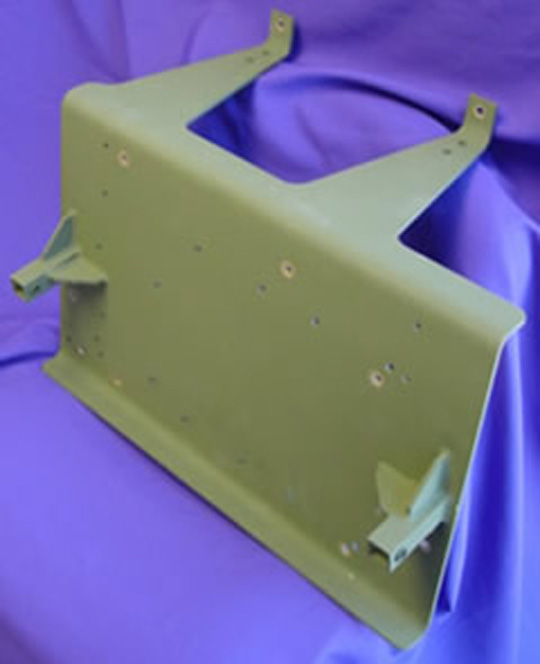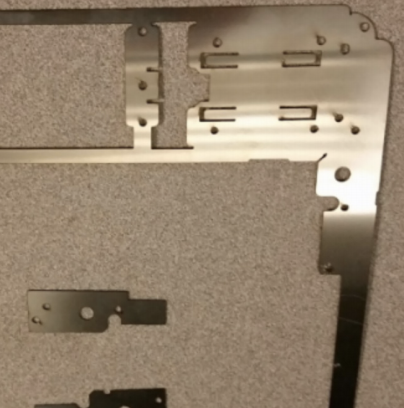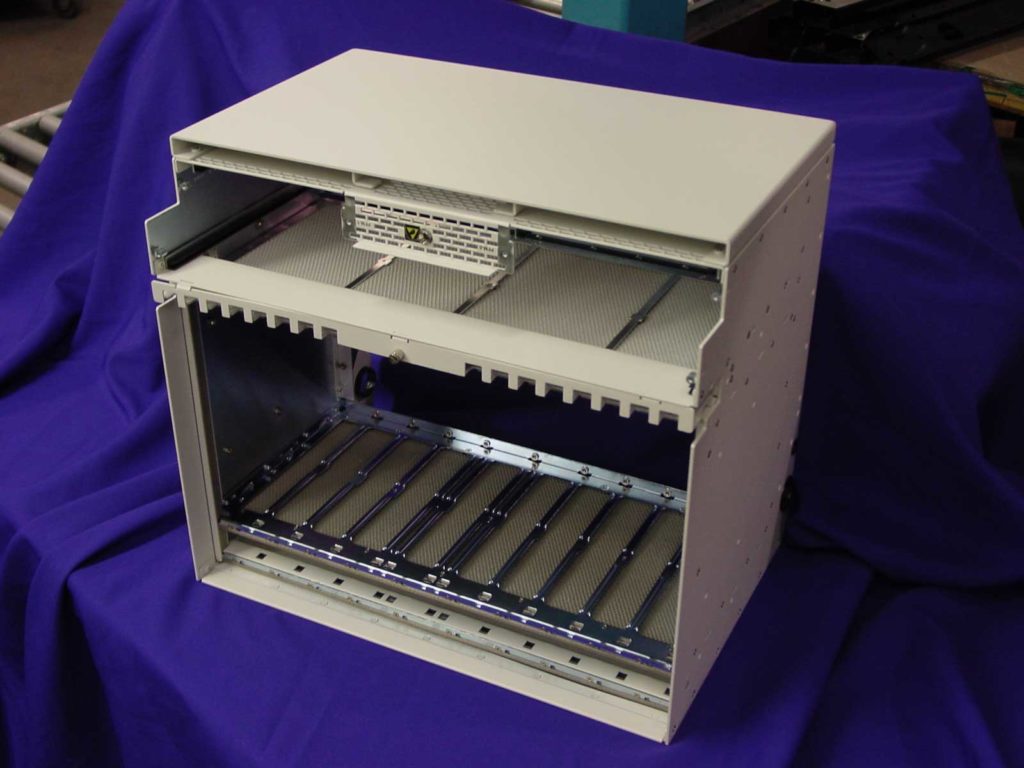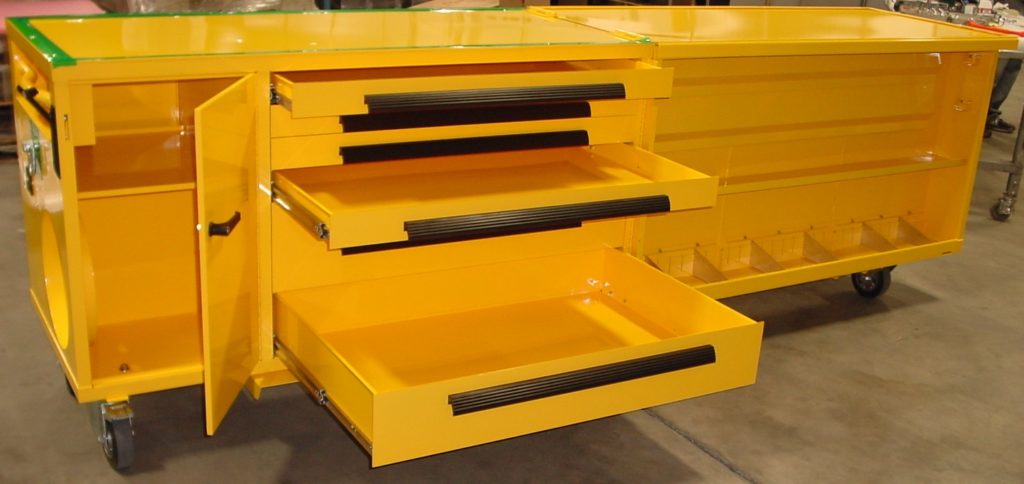Precision sheet metal fabricators offer a range of fabricating capabilities for items big and small, and it’s critical to understand the difference between a part, a weldment, and an assembly when embarking on a metal fabrication project. Below are descriptions of each, along with examples of how they all fit together to create various finished products.
Precision Fabricated Sheet Metal Parts
At the center of it all is the fabricated sheet metal part, of which there are many. Sheet metal parts are single items, which can be fabricated for use as-is, or joined together in any number of configurations to create a larger item, such as a weldment. From there, weldments, as well as additional sheet metal parts, can be joined together to create metal assemblies of various shapes and sizes.
Weldments

Metal parts that have been joined together by welding are usually referred to as weldments. They can consist of any number of pieces, and the size can vary greatly depending upon its intended use. When multiple weldments are joined together, often with additional parts like brackets or panels, they are called sheet metal assemblies.
Metal Assemblies
This term has led to confusion for more than one person because an assembly can refer to a product, a process, or a service. For example, EVS Metal offers assembly and integration services, which means there is a department that specializes in assembling (as a process) metal parts and weldments into larger products. These larger products that have been assembled are often then called “assemblies” (or “an” assembly), meaning they are made up of a collection of smaller parts that have been joined together in any number of ways, including welding, fastening, riveting, or even gluing via the use of certain industrial adhesive materials.
A metal assembly can refer to a huge range of assembled products. They are often made up of a combination of weldments that are joined together with single parts like brackets or panels, to create a finished item, including enclosures like server racks, cabinets, or carts.
Sheet Metal Brackets

Brackets are an extremely useful type of sheet metal part. Brackets can be fabricated in nearly any size, depending on the project’s requirements. Smaller brackets are used for products like enclosure shelves, while larger ones can be found in structural steel projects, such as those EVS Metal fabricated for the new Tappan Zee Bridge project in 2015.
Metal brackets also come in various shapes meant for specific purposes. Z-brackets, for instance, are generally used when mounting offset parallel surfaces within a metal enclosure. Gusset brackets, on the other hand, usually form a triangular shape, and are meant to supply additional strength and rigidity within a weldment or assembly. L-brackets are often used when it’s necessary to mount a vertical component to a horizontal surface (or horizontal components to vertical surfaces, for that matter), and are helpful for mounting shelves within an enclosure. Other common bracket types include offset brackets (similar to z-brackets) and u-brackets (used for mounting parallel surfaces together).
Metal Hinges
Metal hinges allow for movement between two parts of a metal assembly or finished product by allowing the two parts or surfaces to rotate around a fixed axis point. The most common type of hinges make it possible to open and close a door or lid, like those found on cabinets and boxes. A hinge can be fabricated out of both steel and aluminum, and the metal choice depends largely on the application. Aluminum is lighter, but not quite as strong as stainless steel, however, because it doesn’t rust, is a good choice for products that will get wet or are to be placed in humid locations. While steel can be used outside, it is not always the best choice for these projects. However, it is nearly always necessary to use steel for structural projects like bridges due to its strength, regardless of the environment.
Industrial Metal Supports
Metal supports are used for many applications, but this label tends to refer to structural steel parts used in construction. These can include beams, poles, certain types of brackets, pipes and tubes.
Commercial Metal Frames
Metal frames are a type of weldment and/or assembly. They are available in a wide range of sizes and types, depending on their intended use. Metal frames can be fabricated from structural steel for construction projects, or other industrial applications. However, smaller frames, like those for doorways, windows, shelving, or even assemblies like certain kinds of carts are all part of the frame category as well, and can be manufactured using metals like stainless steel or aluminum.
Fabricated Metal Arms
Metal arms can be manufactured from a combination of parts, weldments, or assemblies, depending on how complex they are. Fabricated arms include manipulating/manipulator arms, in vertical or horizontal orientations, with rocker or double-rocker suspensions. They can be powered by electric, pneumatic or hydraulic systems. Other types of arms include those for various types of lighting, from large industrial lights and architectural styles, to simpler desk lamps.
Fabricated Metal Lids and Covers
Metal lids are exactly what they sound like — a cover that fits over another object in order to seal, secure or close it. Garbage can lids, circular screw-top canister lids, metal fuse box covers, and metal cabinet doors are all types of lids.
Commercial Metal Panels

Sheet metal panels can be a confusing category, as the term is used to refer to two very different types of panels. There are architectural panels, which are primarily decorative in nature, and often used for commercial building projects, but the majority of fabricated metal panels are smaller and simpler than these. For instance, metal panels are often used to house electrical components when joined with other parts, such as covers and hinges. An excellent example of this is the common fuse box found in almost every electrified home and business.
Fabricated Metal Enclosures

Sheet metal enclosures are a huge category, and are the end-product of a nearly endless combination of parts, weldments and/or assemblies. They are most commonly fabricated from aluminum or stainless steel, and generally refer to commercial or industrial items. Examples of stainless steel and aluminum fabricated enclosures include cabinets, containers, cages, and even some types of carts, like those used to transport medical supplies between operating rooms. The main commonality is that all enclosures are designed to hold, store, or protect other, smaller items, from computer servers to commercial construction waste.
Metal Boxes
The term “metal box” is often used as a generic way to describe any sheet metal enclosure with 5 or 6 sides (the 6th being the addition of a cover, lid or door). They are manufactured from a variety of metals, like stainless steel and aluminum, and are available in any number of sizes. Box enclosures can be very simple, or much more complex when other parts are added. Examples of metal boxes include toolboxes, pull boxes, hinged boxes, and latch boxes.
Commercial Metal Cabinets

Metal cabinets are their most basic are simply metal boxes with doors attached, usually via a type of bracket and hinge, and are fabricated in a wide range of sizes. There are smaller cabinets, like metal surgical carts, that add wheels to allow them to be used to transport instruments, and large cabinets like school and gym lockers, which are stationary but add security measures like locks to secure valuables. Cabinets may contain inner racks, shelves, or drawers, depending on their intended use.
Industrial Metal Containers
A common type of commercial container are those used to transport goods via cargo ship over water and then by train overland. These are also called “dry” shipping containers. Other types of metal containers are storage and moving “pods.” Smaller types of containers are also available, and tend to be modular and or stackable for use as storage in warehouses and other similar environments.
Commercial Metal Bins
A metal bin is essentially a type of container, but they generally are not fitted with covers, which means they cannot be used to secure valuable items. They are used both indoors and out, for a wide variety of applications. Some common types of metal bins are those used to store and consolidate waste and/or transport materials on a construction job site. Although most bins are not used to store valuables, there are industrial bins available that feature covers and locks to store and protect large, expensive equipment that cannot be easily moved back and forth from day to day, like that which is used for long-term road work projects.
Smaller types of metal bins are also available, although generally meant for indoor use. These are used in commercial and industrial settings, in particular warehouses, and are often stackable to make the best use of space.
EVS Metal: Specialists in Fabricated Metal Parts, Weldments and Assemblies
EVS Metal is a full-service provider of fabricated stainless steel and aluminum products, whether for single parts or fully assembled enclosures. To submit an RFQ for a metal fabrication project at one of our four facilities in New Jersey, Texas, New Hampshire or Pennsylvania, send a quote request online, or call 1-888-9EVSMET.





